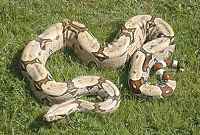God's creation articles
 |
Of the world's more than 2,500 kinds of snakes, the largest are anacondas and boa constrictors living in the swamps and tropical forests of South and Central America, and pythons in southeastern Asia, Africa and India.
The 12-foot boa constrictor is smaller than the 30 to 40 foot anacondas and pythons which are as big around in their middles as a fully grown teenager. All kill their prey by coiling around their bodies and constricting (squeezing) them to death, then swallowing them whole. They do not actually "eat" their food, but draw their hinged, elastic mouths over it, the non-poisonous fangs then pull it into their bodies an inch or two at a time. After a big meal the snake may not eat again for three or four months or more.
The long, flat head of these snakes has no ears. Vibrations and a keen sense of smell, received in part through a flicking tongue, make them aware of what is nearby. They never stop growing, although their skins do. Twice a year a new skin replaces the tight uncomfortable old one which is rubbed off — a startling thing to come across as it lies empty on the grass or on a rocky ledge.
Anacondas and boas give birth to live babies, but pythons lay eggs, incubated by the mother coiling around them. Either way, the "little" ones, as many as six dozen at a time and as much as two feet long at birth, immediately know how to squeeze small victims to death.
The boas spend a great deal of time in water, often with only a small part of their heads showing, waiting for animals to come near. At other times they climb trees to rob bird nests, or stretch out on a low limb to dart down and catch animals passing below. Pythons in their part of the world have similar habits, sometimes tangling with tigers or other big animals. Once they get their coils around their prey they are almost sure to win these battles. But such victims are too big to eat, and these contests only happen when for some reason they attack one another.
These reptiles have a place and purpose in God's creation, but most people find them repulsive, especially so when remembering that in the Bible Satan himself is called "that old serpent, which is the Devil."
When the Israelites in the wilderness spoke against God (Numbers 21:4-9), He sent fiery serpents among them and many died. But the Lord did provide a way of escape, telling Moses to place a brass serpent on a pole and any who simply looked on it were healed. This is a type of the Lord Jesus Christ who later died for sinners on Calvary's cross, with the wonderful promise that "whosoever believeth in Him should not perish, but have eternal life," as our opening verse states.
Have you confessed that you are a sinner and looked in faith to the Lord Jesus to save you?
Copied with permission from Messages of God's Love. More articles in The Wonders of God's Creation (Volume 1-4) by Sidney R. Gill, also published by Bible Truth Publishers, Addison, IL 60101.
>> More God's Creation Articles